Chem 301 unit 6 - Study guides, Class notes & Summaries
Looking for the best study guides, study notes and summaries about Chem 301 unit 6? On this page you'll find 27 study documents about Chem 301 unit 6.
Page 3 out of 27 results
Sort by
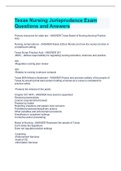
-
Texas Nursing Jurisprudence Exam Questions and Answers
- Exam (elaborations) • 7 pages • 2023
-
- $9.79
- + learn more
Primary resources for state law - ANSWER Texas Board of Nursing Nursing Practice Acts Nursing Jurisprudence - ANSWER Rules/ Ethics/ Morals and how the nurses function in a healthcare setting Texas Nurse Practice Acts - ANSWER 301 -BON, , defines responsibility for regulating nursing education, licensure and practice 303 -Regulates nursing peer review 304 -Relates to nursing Licensure compact Texas BON Mission Statement - ANSWER Protect and promote welfare of the people of Texas by ensuring that ...
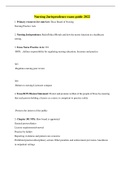
-
Nursing Jurisprudence exam guide 2022
- Exam (elaborations) • 15 pages • 2022
-
- $12.49
- + learn more
Nursing Jurisprudence exam guide 2022 1. Primary resources for state law: Texas Board of Nursing Nursing Practice Acts 2. Nursing Jurisprudence: Rules/Ethics/Morals and how the nurses function in a healthcare setting. 3. Texas Nurse Practice Acts: 301 -BON, , defines responsibility for regulating nursing education, licensure and practice 303 -Regulates nursing peer review 304 -Relates to nursing Licensure compact 4. Texas BON Mission Statement: Protect and promote welfa...
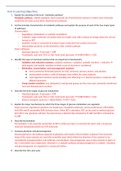
-
CHEM 301 - Unit 6 Review.
- Exam (elaborations) • 11 pages • 2021
-
- $11.49
- + learn more
CHEM 301 - Unit 6 Review. Unit 6 Learning Objectives 1. Explain the meaning of the term “metabolic pathway.” Metabolic pathway = tightly regulated, interconnected set of biochemical reactions in which some chemicals (nutrients) are used up and other chemicals.
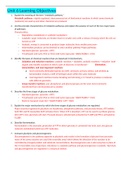
-
CHEM 301 - Unit 6 Review / CHEM301 - Unit 6 Review:LATEST 2021
- Exam (elaborations) • 11 pages • 2021
-
- $11.99
- + learn more
CHEM 301 - Unit 6 Review / CHEM301 - Unit 6 Review:LATEST 2021CHEM 301 - Unit 6 Review/CHEM 301 - Unit 6 Review. Unit 6 Learning Objectives 1. Explain the meaning of the term “metabolic pathway.” Metabolic pathway = tightly regulated, interconnected set of biochemical reactions in which some chemicals (nutrients) are used up and other chemicals are produced 2. List the principle characteristics of metabolic pathways and explain the purpose of each of the two major types of pathways. Characte...
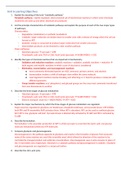
-
CHEM 301 - Unit 6 Review.
- Exam (elaborations) • 11 pages • 2021
-
- $11.99
- + learn more
CHEM 301 - Unit 6 Review/CHEM 301 - Unit 6 Review. Unit 6 Learning Objectives 1. Explain the meaning of the term “metabolic pathway.” Metabolic pathway = tightly regulated, interconnected set of biochemical reactions in which some chemicals (nutrients) are used up and other chemicals are produced 2. List the principle characteristics of metabolic pathways and explain the purpose of each of the two major types of pathways. Characteristics: - Degradative (catabolism) or synthetic (anab...
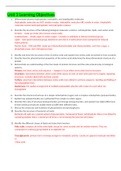
-
CHEM 301 - Unit 3 Review / CHEM301 - Unit 3 Review:LATEST 2021
- Exam (elaborations) • 25 pages • 2021
-
- $11.19
- + learn more
CHEM 301 - Unit 3 Review / CHEM301 - Unit 3 Review:LATEST 2021CHEM 301 - Unit 3 Review/CHEM 301 - Unit 3 Review. Unit 3 Learning Objectives 1. Differentiate between hydrophobic, hydrophilic, and amphipathic molecules. Hydrophobic molecules are NOT soluble in water. Hydrophilic molecules ARE soluble in water. Amphiphilic molecules contain both hydrophobic and hydrophilic residues. 2. Describe the structure of the following biological molecules: proteins, carbohydrates, lipids, and nucleic acids. ...
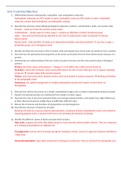
-
CHEM 301 - Unit 3 Review.
- Exam (elaborations) • 23 pages • 2021
-
- $11.99
- + learn more
CHEM 301 - Unit 3 Review/CHEM 301 - Unit 3 Review. Unit 3 Learning Objectives 1. Differentiate between hydrophobic, hydrophilic, and amphipathic molecules. Hydrophobic molecules are NOT soluble in water. Hydrophilic molecules ARE soluble in water. Amphiphilic molecules contain both hydrophobic and hydrophilic residues. 2. Describe the structure of the following biological molecules: proteins, carbohydrates, lipids, and nucleic acids. Proteins – made up of AAs (20 common amino acids) Car...

$6.50 for your textbook summary multiplied by 100 fellow students... Do the math: that's a lot of money! Don't be a thief of your own wallet and start uploading yours now. Discover all about earning on Stuvia


